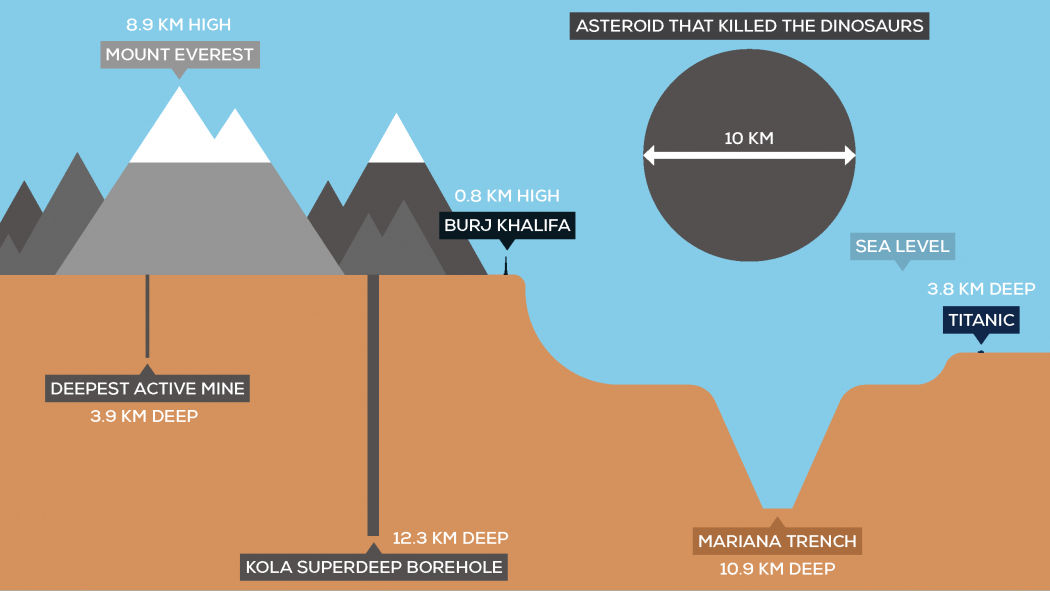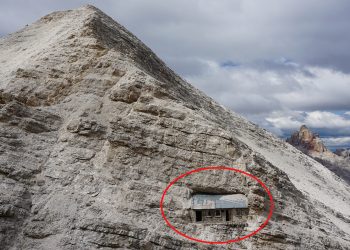As much as humankind loves exploring the universe, we love exploring what’s beneath the oceans, although not quite as passionately. Thirdly, we also love digging holes on Earth, figuring out what exactly is located at extreme depths.
Throughout history, humankind has drilled holes in the ground for different reasons.
Sometimes in the name of science, sometimes in the name of money, but whatever the reason was, we really dug some massive holes in the Earth. But we also found that mother nature is good at creating them too.
In this article, we take a look at some of the deepest holes on Earth.

The Great Blue Hole
Located in Belize, the Great Blue hole is a unique tourist attraction. The monstrous hole is actually a sinkhole located just off the coast of Belize. The Great Blue hole was recently explored and stretched around 984 feet across and is about 410 feet deep.
The Diavik Mine
Located in Canada, the Diavik Mine is owned by the Dominion Diamond Corporation. The mine holds the title of being Canada’s largest diamond mine in terms of production. According to reports, the mine is 600 feet deep, is also one of the deepest holes in the world.
Kimberly Diamond Mine
Another mine. Another Diamond Mine, and another Massive one at that. The Kimberly Diamond Mine. Located in South Africa, it holds the title of the world’s largest hand-dug hole. Around 50,000 miners dug it. It was officially opened in 1871 and closed in 1914. The massive hole that resulted from the mine is nearly 800 feet deep.

Mirny Diamond Mine
You guessed it. Another Diamond Mine. This one is located in Russia and is one of the largest diamond mines opened in the USSR. The mine is no longer in operation. It is more than 1,700 feet deep and has a diameter of around 3,900 feet. The Mirny Diamond Mine holds the title as the second largest hole excavated on Earth and the fourth deepest open-pit mine.
Bingham Canyon Mine
From diamond mines, we jump to copper mines. Located in Utah, the Bingham Canyon mine is more than 100 years old. It is considered the largest manufactured excavation. The mine has been in production since 1906 and has resulted in the creation of a pit over 0.6 miles (970 m) deep, 2.5 miles (4 km) wide, and covering 1,900 acres (3.0 sq mi; 7.7 km2). The mine dips down around 3,200 feet.
The Chuquicamata Copper Mine
Located in Chile, the mine, better known as Chuqui, is believed to produce the most copper in the world. At around 2,800 feet deep, it’s one of the largest holes ever dug into the Earth.
The Berkley Pit
Another massive copper mine. The Berkley Pit in Montana is around 1700 feet deep. It was closed in 1982. Since then, the mine has been filled with more than 900 feet worth of groundwater and rainwater.
Udachnaya Pipe Mine
From Montana, we travel back to Russia to take a look at the Udachnaya Pipe Mine. Located in western Yakutia, the massive mine stretches 5,249 by 6,561 feet, and it is 2,099 feet deep.
The Darzava Gas Crater
From man-made mines and holes, we return to those created by mother nature. Known as the door to hell, the Darzava Cater is a sinkhole that rightfully holds the title as one of the most unique holes in the world: its constantly on fire. Four decades ago, Soviet scientists set fire to gasses during a drilling project. Ever since the sinkhole has continued burning, it is around 230 feet wide and 100 feet deep.
IceCube Neutrino Observatory
We travel to Antarctica to see a massive hole that took more than seven years to drill. IceCube consists of spherical optical sensors called Digital Optical Modules (DOMs), each with a photomultiplier tube (PMT0) and a single-board data acquisition computer that sends digital data to the counting-house on the surface above the array. DOMs are deployed on strings of 60 modules, each at depths between 1,450 to 2,450 meters into holes melted in the ice using a hot-water drill.

Kola Superdeep Borehole
With only around 9 inches in diameter, the Kola Superdeep Borehole has a mind-bending depth of 39,600 feet. The massive super hole stretches a staggering 7.5 miles into the Earth and is considered the second longest borehole ever created. The project began in 1970 and was abandoned in 2008 after reaching a depth where drilling was impossible to continue. The Kola Superdeep Borehole is deeper than the deepest part of the ocean. In terms of depth below the surface, the Kola Superdeep Borehole SG-3 retains the world record at 12,262 meters (40,230 ft) in 1989 and is still the deepest artificial point on Earth.
Z-44 Chayvo well
Considered the world’s longest extended-reach well offshore, the Z-44 Chayvo well is located on the Russian island of Sakhalin. On 27 August 2012, Exxon Neftegas Ltd completed the Z-44 Chayvo well and reached a measured total length of 12,376 meters (40,604 ft).
Join the discussion and participate in awesome giveaways in our mobile Telegram group. Join Curiosmos on Telegram Today. t.me/Curiosmos











